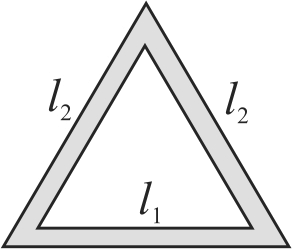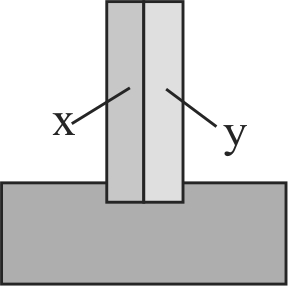366772
An isosceles triangle is formed with in a rod of length \(l_{1}\) and coefficient of linear expansion \(\alpha_{1}\) as the base and two thin rods each of length \(l_{2}\) and coefficient of linear expansions \(\alpha_{2}\) as the two sides. If the distance between the apex and the midpoint of the base remain unchanged as the temperature is varied, then
366773 A hole is drilled in a copper sheet. The diameter of the hole is \(4.24\;cm\) at \(27^\circ C\). What is the change in the diameter of the hole when the sheet is heated to \(227^\circ C\) ? Coefficient of linear expansion of copper is \(1.70 \times {10^{ - 5}}/\,^\circ C\).
366772
An isosceles triangle is formed with in a rod of length \(l_{1}\) and coefficient of linear expansion \(\alpha_{1}\) as the base and two thin rods each of length \(l_{2}\) and coefficient of linear expansions \(\alpha_{2}\) as the two sides. If the distance between the apex and the midpoint of the base remain unchanged as the temperature is varied, then
366773 A hole is drilled in a copper sheet. The diameter of the hole is \(4.24\;cm\) at \(27^\circ C\). What is the change in the diameter of the hole when the sheet is heated to \(227^\circ C\) ? Coefficient of linear expansion of copper is \(1.70 \times {10^{ - 5}}/\,^\circ C\).
366772
An isosceles triangle is formed with in a rod of length \(l_{1}\) and coefficient of linear expansion \(\alpha_{1}\) as the base and two thin rods each of length \(l_{2}\) and coefficient of linear expansions \(\alpha_{2}\) as the two sides. If the distance between the apex and the midpoint of the base remain unchanged as the temperature is varied, then
366773 A hole is drilled in a copper sheet. The diameter of the hole is \(4.24\;cm\) at \(27^\circ C\). What is the change in the diameter of the hole when the sheet is heated to \(227^\circ C\) ? Coefficient of linear expansion of copper is \(1.70 \times {10^{ - 5}}/\,^\circ C\).
366772
An isosceles triangle is formed with in a rod of length \(l_{1}\) and coefficient of linear expansion \(\alpha_{1}\) as the base and two thin rods each of length \(l_{2}\) and coefficient of linear expansions \(\alpha_{2}\) as the two sides. If the distance between the apex and the midpoint of the base remain unchanged as the temperature is varied, then
366773 A hole is drilled in a copper sheet. The diameter of the hole is \(4.24\;cm\) at \(27^\circ C\). What is the change in the diameter of the hole when the sheet is heated to \(227^\circ C\) ? Coefficient of linear expansion of copper is \(1.70 \times {10^{ - 5}}/\,^\circ C\).


